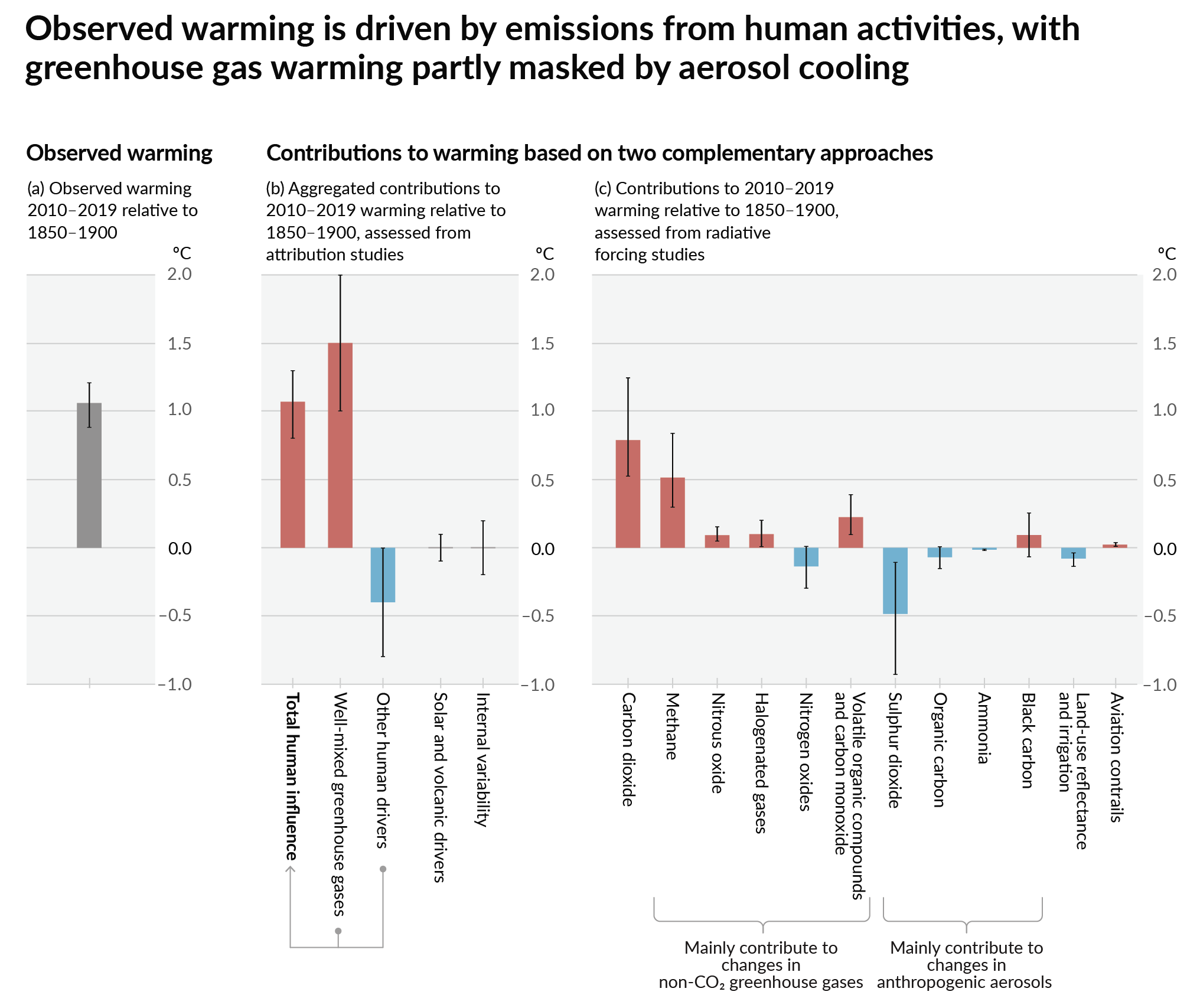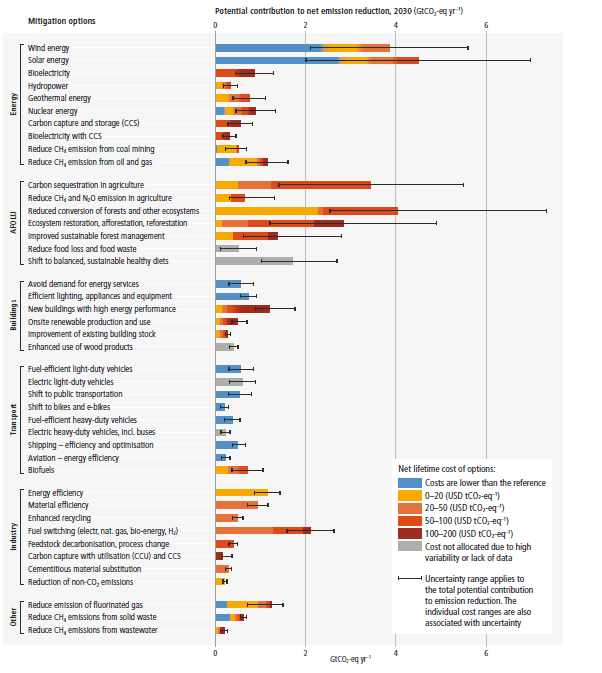ie they ignored several decades of climate science and now we all get to pay the price.
can't compete with chinese automakers on price, performance or access to batteries so now they are retreating to their protected markets.
Discussion of climate, how it is changing, activism around that, the politics, and the energy systems change we need in order to stabilize things.
As a starting point, the burning of fossil fuels, and to a lesser extent deforestation and release of methane are responsible for the warming in recent decades:

How much each change to the atmosphere has warmed the world:

Recommended actions to cut greenhouse gas emissions in the near future:

Anti-science, inactivism, and unsupported conspiracy theories are not ok here.
ie they ignored several decades of climate science and now we all get to pay the price.
can't compete with chinese automakers on price, performance or access to batteries so now they are retreating to their protected markets.
Plug in hybrids make a lot of sense during this transitional period of rapidly advancing battery technology and incomplete deployment of charging infrastructure.
Building a small, relatively cheap factory for manufacturing a small number of super expensive, pavement princess trucks is less risky than making a large investment in a megafactory capable of producing a meaningful number of affordable cars. That big car factory would need the market to demand its products for a long time for the investment to pay off. For example, if there's a big leap in battery tech in the near future, the car manufacturer would take a loss - either they continue to offer outdated EVs and sell fewer than projected (only utilizing a fraction of the factory's maximum output, while still paying taxes and maintenance on a larger facility), or they throw away their expensive, brand new factory tools and build expensive new ones for manufacturing cars with the new batteries.
Meanwhile, charging an EV at home still isn't possible for a lot of people, and quick charger stations aren't available yet in a lot of areas. However, a plug in hybrid can be adequately charged overnight by a standard home electrical outlet, letting it act like an EV for quick trips around town. Meanwhile, longer trips into not-yet-electrified areas are still possible thanks to the ICE, and the range can be quickly topped up at a gas station. More plug in hybrids on the roads also generates demand for building charging infrastructure - if someone just has $5 to spend on gas, they could get more miles by spending it on electricity at a quick charger.
Honestly plug in hybrids are the worst of both worlds.
There was a study recently from Europe that found the vast majority of people with plug in hybrids hardly every plugged them in, and drove them like normal cars. That defeats the entire point of a plug in hybrid, and now you are carrying a heavy battery everywhere that you are not fully using. Which makes the car less efficient than a normal hybrid!
Yeah, it depends on the user.
I had an alcoholic neighbor with learning disabilities who had a PHEV minivan purchased for them, and they only kept the battery charged for the first few months of ownership. After that, they seemed to lose interest in plugging it in when they got home.
On the other hand, a friend of the family owns a PHEV sedan they keep charged religiously, and they need to buy fuel stabilizer because they almost never use any gas.
An alcoholic neighbour and someone purchased a car for them?
don't get me started
You can't fix stupid. You can argue plugin hybrids are bad on the pragmatic argument that people don't charge them and that's fair, but to say they are the worst is just wrong. The have the potential to be the best.
Well let me clarify a bit why I think they are the worst.
They have the full complexity an an ICE car, with the added difficulties that arise in a full EV
You need to build and design a car that has all of the downsides of ICE cars. Complicated engine, emissions management, fuel, air intakes.
With a lot of the downsides of an ev. Large heavy, expensive batteries.
Meanwhile you get limited upsides. Evs get lower maintenance and transport costs and ICE cars get range.
Plug in hybrids will have harder maintenance than either, while not getting the fully reduced transport costs as it's not as efficient as a full ev.
Here's where traditional hybrids win out, their battery can be really small, correspondingly cheap and more efficient.
Lugging all that extra weight around decreases the efficiency of the vehicle, where for full ev that matters a lot.
When running in full gas mode your lugging around a heavy battery for nothing, and in a full ev mode your lugging around a heavy engine for nothing.
The High-medium range of full gas would be better served by a traditional hybrid, and the low-medium range would be better served for full evs.
I'm sure there is a narrow window for plug in hybrids, but again that is going to be rare and shrinking as evs get better.
While you can't fix stupid, we do have to think about how a product actually gets used vs it's design.
If nobody is plugging their plug in hybrid, then maybe the manufacturer should remind them, even if its only outlet level power.
To me it is also a symbol of overconsumption. Buying a vehicle that will cover 100% of your use cases vs buying for 99% and renting a more suitable option for that 1%.
I do think this argument for me would change if manufacturers took a different approach. If they took something like a traditional hybrid, like a Ford fusion, and stuck a modern battery in and added a simple plug would be great. Then increase the efficiency a bit and maybe someone could get 10 miles of battery from a regular outlet.
I get a lot of engineers at my job who don't understand the concept but they react to it in extreme ways. Like when we talk about plasma, there would always be someone bringing up how you can't use certain materials near plasma or near heat or in vacuum. Yet some how the machines we make work and you even have on your hands a little TV screen powered by all sort of circuitry that shouldn't exist because x or y factor that some guy always thought wouldn't work because they were not in the team that actually made the thing work. But do keep telling us how plug-in hybrids don't work. I only spent a decade in that industry actually developing motors, gear drives battery packs etc, and just so that some guy over here who maybe had one or drove one last week and has some options now controls the conversation. To me. Seeing is believing. I drive a little hybrid, I watch the gauge and it tells me, hey you got 57 mpg! Yey! But what I believe is that I do maybe 14 trips a year to go get gas and it's way cheaper than when we fill up the van. As a user of my Toyota hybrid, that's the bottom line regardless of my engineering degree and years of experience in the matter.
Not necessarily. In our case, we have a hybrid SUV that we’ve used on several road trips, however most of the driving is within the 40 mile range. At the time, there was no plug in hybrid option, but if there was, it would have been perfect. Battery for most daily driving, but no range anxiety for any road trips.
Have automakers gotten so used to fat profit margins from SUV sales, particularly during the post-pandemic boom, that they consider anything that requires investment to be "insufficiently profitable"? Or has the high-return mindset of Silicon Valley infected Detroit as well?
Indeed,
"Ford just reported a massive loss on every electric vehicle it sold"
https://www.cnn.com/2024/04/24/business/ford-earnings-ev-losses/index.html
That's R&D cost divided over a small number of vehicles, not the cost of material and labor that goes into each vehicle. It only looks bad on paper.
For example, if you invest $100 in R&D and it costs $1 to produce each car, then the first car out of the factory costs $101. Sell that first car for $10 and you've "lost" $91. But if you can sell 100 cars, then each car only costs $2, not $101, and now on paper it looks like you've made $8 on each sale.
Time will tell if Ford made the right decisions about what kind of car to engineer and if consumers will continue to buy it long enough to make back the one time R&D expenses. That would happen faster if their margins on labor and material is high, like it is on trucks and SUVs, which makes those a safer investment.
@Delta_V going back many years I've heard the description of the automobile industry problem as "overcapacity."
Too many companies in too many countries are fighting for too few buyers, compared to that production capacity. Like, if you ran all plants atlnd all shifts it would be way too many cars.
Now that's happening in EVs right?
To make money, on specifically the Mustang, Ford it has to sell a lot of Mustangs. Unfortunately everyone else is trying the same thing at the same time.
I'm skeptical of the problem being that simple. I think if that were the only issue, we would have cheaper cars.
Part of the rational for producing high margin trucks and SUVs is that investors demand the most margin possible out of every unit of production capacity. If a factory can only turn out 100 vehicles a year, its more profitable to turn out an expensive SUV that only 100 people can afford, compared to selling 100 cheap sedans that thousands of people want but you just can't produce enough of them.
If there were overcapacity, then in a vacuum, it would make sense to put it to work turning out low margin cars that are in high demand and making some money with that capacity instead of no money.
But its hard to predict years in advance when your factories are going to have excess capacity, and to know when to begin years long engineering projects so the vehicles you're going to want to produce will have their designs finished in time to fill those gaps. And its extra risky to begin those kinds of long range projects during times of rapidly changing regulations of ICE vehicles, and rapidly advancing tech for EVs that might invalidate years of engineering and factory tooling investments because you can't sell the vehicle you planned to produce for a long enough time to make back your investment and start seeing a profit. Not that I'm anti-regulation - I like breathing clean air and drinking clean water.
At least in Europe, there are a few big reasons. First and foremost combustion engines are more profitable. EV require a lot of R&D and factory investment, which is not needed for old school combustion engines. The other part is a shrinking car market. Covid means a lot more work from home and at least in Europe, you generally have the option of doing a lot of things on foot, bicycle or public transport. At the same time, when you drive less you do not go for a new car as quickly. Then you have cost. Due to supply chain issues battery prices have not fallen quickly enough. There was a bit of time, when they were stable. Good news is that they are falling again.
In other words, this is a difficult transition and some car makers are going to fail.
And the world will be better for it.
Spending 20% of MSRP on incentives is not profitable or sustainable